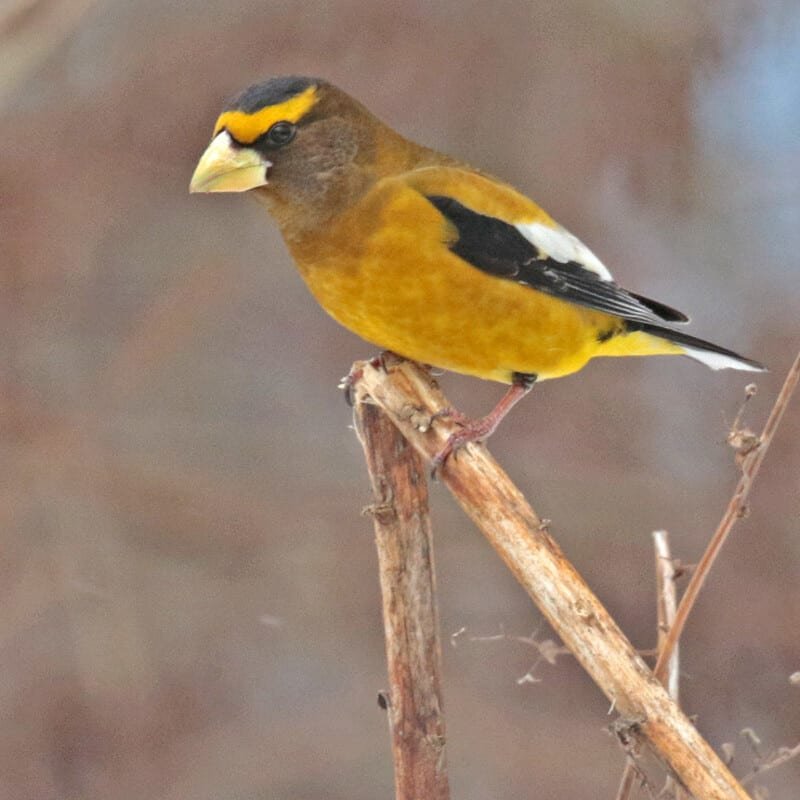The evening grosbeak, Hesperiphona vespertina is a North American passerine bird of the finch family Fringillidae. Evening Grosbeaks are stocky, large-billed finches that inhabit northern coniferous forests. Throughout much of its range, it is an irruptive migrant that makes roughly biannual appearances at winter feeding stations across much of the conterminous United States.
Quick Overview: Coccothraustes Vespertinus – Evening Grosbeak
Body size: Around 7.75-8.5 in (20-22 cm) and a weight of 60 g (2.1 oz).
Main colors: Yellow, Brown, Gray, White
Range: North Western United States
Migratory Bird: Yes
Best time of the year to see in the U.S.: All Year (January – December)
Conservation Status: Least Concern
Evening Grosbeak Description
Finch, large and stocky. The male’s back, rump, and underparts are bright yellow. Dark brown head with a large, pale bill; bright yellow brows that extend onto the forehead. Dark wings with prominent white secondary patches; dark tail. Females and juvenile females are similar in appearance but grayer and with white-tipped tails; the secondary wing patch is gray, while the base of the inner primaries is white. Male juveniles resemble female juveniles but have white secondaries.

Size
These birds have a length of 7.75-8.5 in (20-22 cm) and a weight of 60 g (2.1 oz). Their wings could range from 33-35 in (13-13.75 cm).
Feeding
Although the evening grosbeak’s diet is primarily comprised of seeds and fruits, it also consumes insects. It favors maple, spruce, pine, fir, and balsam tree seeds. Evening grosbeaks are frequent visitors to bird feeders, where they are particularly fond of sunflower seeds.
Habitat
Breeding habitats include coniferous and mixed forests throughout Canada, as well as western mountainous regions of the United States and Mexico. It is a very uncommon vagrant to the British Isles, with only two records. The nest is constructed on a horizontal branch or in a tree fork.
Behavior
The Evening Grosbeak’s decline could be attributed to tar sands exploitation, which has destroyed large swaths of its boreal breeding habitat, which is also shared by Blackpoll Warbler and Swainson’s Thrush. Global warming may further erode boreal habitats in the coming years.
Coccothraustes Vespertinus Scientific Classification
- Kingdom: Animalia
- Phylum: Chordata
- Subphylum: Chelicerata
- Class: Aves
- Order: Passeriformes
- Family: Fringillidae
- Genus: Hesperiphona
- Species: Hesperiphona vespertina
Best time of the year to see
In the United States, the best time of year to see these birds is all year round, regardless of the season. This refers to any month of the year between January and December.
Distribution of the Evening Grosbeak in the USA
Breeds from British Columbia to Newfoundland, and further south to northern New England, Minnesota, Mexico’s mountains, and California. Winters in the southern states of California, Texas, and the Gulf Coast.
The Evening Grosbeak can be found in the following states in the United States – Alaska, Arizona, Colorado, Connecticut, Hawaii, Idaho, Illinois, Indiana, Maine, Massachusetts, Michigan, Montana, Nevada, New Hampshire, New Mexico, New York, North Dakota, Ohio, Oregon, Pennsylvania, Rhode Island, South Dakota, Utah, Vermont, Washington, Wisconsin, and Wyoming.
